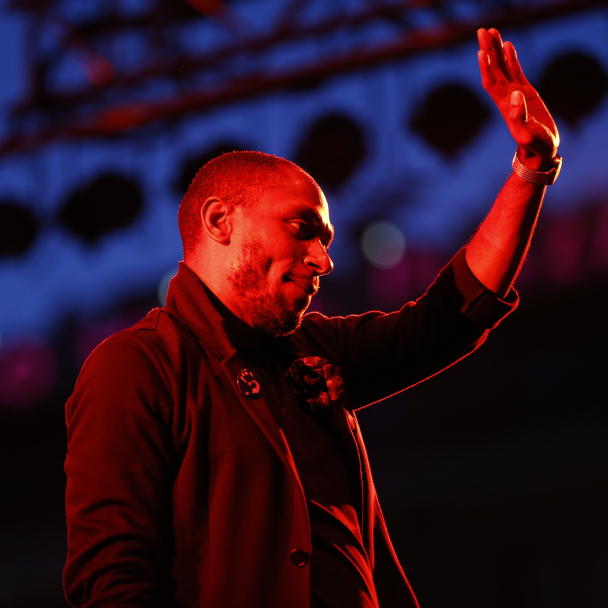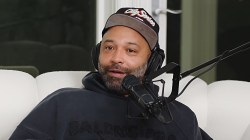Yasiin Bey retiring? Yeah, maybe. But Mos Def will live on in our hearts as the guy who made “Ms. Fat Booty” and “Umi Says.” The guy who straddled the line between stone cold lyricist and master of pulchritude. He was the best of all worlds, it seemed. The same cat who could freestyle in a cypher with the most fearsome MC’s, yet go to the studio and make “The Beggar” and “The Panties.” He traveled but he stayed in the hood. He seemed to have a hand in just about every pie.
And sometimes his music suffered for it. But not too much to make us forget why we thought mighty Mos Def was so ill to begin with. I recently revisited each of the Brooklyn MC’s releases, comparing their early legacies to their lasting impacts.

Mos Def and Talib Kweli Are…Black Star
There is only one Black Star album, but there’s a reason that fans have been begging for a follow-up for nearly 20 years: Yasiin Bey and Talib Kweli made history. The two Brooklyn MCs had already shown a magical chemistry with “Fortified Live” from Rawkus Records’ Soundbombing compilation and put their solo endeavors on hold to collaborate on Black Star. The result was a blueprint that conscious MCs would follow for years to come. They deftly referenced iconic black works and ideas to tackle modern issues. “Definition” reworked Boogie Down Productions’ “Stop The Violence” to pay tribute to the recently murdered 2Pac and Biggie; “Children’s Story” revisited Slick Rick’s song of the same to caution against falling for music industry materialism; “Thieves in the Night” uses a refrain from a passage from Toni Morrison’s novel “The Bluest Eye” to inspire listeners to fight disillusionment and care for themselves. The time period’s budding infatuation with shiny suit rap worked to its detriment, and to its benefit. Some saw Black Star as preachy compared to the escapism from the radio. But others saw it as a comforting reminder of the enlightening empowerment they felt Hip Hop had lost.

AD LOADING...
Yasiin and Talib’s chemistry was so magical because they had similar thought processes but different execution. Talib used an academic, ideological approach to bluntly state ideas and injustices while Yasiin employed vibrant imagery and contagious energy to help bring Talib’s lessons to life. Their one-two punch made them a natural duo for their future collaborations and served as a launchpad for each of their solo careers.

Black On Both Sides
Black On Both Sides was a formative album for me, and my introduction to the Rawkus Records universe. The themes of loss on Puff Daddy and The Family’s No Way Out helped me cope with my mother’s death to cancer, but BOBS was an illustration of what hip-hop was capable of. I had attended all-white catholic schools since first grade, and that album – anchored by singles “Ms. Fat Booty” and “Umi Says” – was the most vivid, comprehensive artistic expression of blackness I had fully consumed by the time I purchased it as a high school sophomore. The iconic cover art – a weary, focused Mos Def glaring back at the listener – acutely embodied the album’s mission as a glimpse into the complexity of black life in America. Mos’ boasts of “I strike the empire black!” and the James Brown-inspired shrieks of “black and proud!” by Busta Rhymes on “Do It Now” rang just as true as the seething resentment toward racism of “Mr. Nigga” or “Rock N Roll.” Jazz, reggae, and soul influences are infused into the album as well. My parents had amassed a collection of African art, jazz records and black literature that adorned our home, and Black On Both Sides would symbolize the first piece of such a collection for me, an opening step into self-discovery and education of my heritage.

AD LOADING...
While the album helped me build identity during such a pivotal moment of my life, it felt even more palpable during my college years at Michigan State University, as I became well-versed with the ways of the world. When I was surrounded by police based on a tip from someone who thought I was trying to steal my own car, the lyrics from “Mr. Nigga” immediately came to mind. When a school administrator sarcastically smirked “hip-hop” while shaking my hand at a ceremony where I and other journalism students were being honored for our achievements, the resentment returned. And as I continued to learn about systemic racism through classes, personal reading and my involvement with black and multicultural student groups, the statistics dropped on “Mathematics” began to make even more sense. Even now, “New World Water” feels prophetic in light of the water crisis in Flint, Mich.
But just like Black On Both Sides, that anger was balanced with a genuine love for being black. Professor Pero Dagbovie was a black history teacher and mentor, and he was in his 30s, showing me that black scholarship wasn’t limited to people in their 40s or 50s like my English professor father. There were also the exercises of language as a member of Black Poets Society, the spades tournaments in our dorm basements, concerts by acts like Talib Kweli and Little Brother in the city and on campus. Sure, I’ve discovered the album’s few flaws when I revisited with more seasoned ears. But with Yasiin Bey’s solo debut, he showed that the black experience is multifaceted, with dangers that are just as real as its joys – and through the highs and lows, we should all stay in it together.

The New Danger
Black Star and Black On Both Sides will always be Yasiin Bey’s most identifiable records, but The New Danger is arguably the most indicative of how many will remember the Brooklyn thespian: fearless, eccentric and limitless. In the years immediately following BOBS, Yasiin Bey adopted a Harlem Renaissance attitude by revisiting his acting roots with ventures in film and Broadway. After nabbing awards, checks, and new fans through appearances in films and plays like “Brown Sugar,” “Top Dog/Underdog” and “The Italian Job,” he used his expanded profile to further challenge listeners’ perceptions of blackness and consciousness on his second album.

AD LOADING...
Many remember The New Danger for its rock star dreams. “Rock n Roll” from Black On Both Sides lamented about the lack of acknowledgment of black influence in rock’s origins, and with Yasiin’s second solo album, he aimed to reclaim a share of that legacy with his band Black Jack Johnson (named after the first black heavyweight champion boxer). The album got mixed reviews when it was released, and the unevenness persists when Yasiin forces his contrasting influences together in unnatural ways: the disjointed “War,” and the odd transition between the slinky “The Boogie Man Song” and the thrashing “Freaky Black Greetings.” But more than a decade later, the rock elements on songs like “Ghetto Rock” and “Zimzallabim” aren’t nearly as jarring; the genre-bending that other artists would employ in subsequent years makes those songs go down easier now.
While the rock attempts are hit or miss, Yasiin’s singing voice is more consistent on the album’s forays into soul, jazz, and R&B, closer to songs like “Umi Says” and “Climb” from BOBS. The somber Marvin Gaye tribute “Modern Marvel” and the seductive “The Panties” are two of his most memorable post-BOBS songs, with his earnestness overshadowing any technical deficiencies. The New Danger has great raps too, but they’re harder to find. Yasiin didn’t bring the same amount of topical rap songs as he did on BOBS, but the rhymes were still sharp on “Close Edge,” “Champion Requiem” and the Kanye West-produced “Sunshine.” And lead single “Sex, Love & Money” effortlessly encapsulated his past and his future: he used both rapping and singing to navigate Warryn Campbell’s funky arrangement of horns, tambourines, and flutes.
Black On Both Sides was largely straightforward rap with only brief detours into other genres, so his experimentalism never came at the expense of what his listeners were used to. The New Danger’s ratio between rap and “other” was the complete opposite, testing the patience of die-hard fans from the Rawkus days. Still, Yasiin Bey’s sophomore album seems closest to his current personality: immensely talented but refusing to rest on his laurels, for better or worse.


AD LOADING...
True Magic
It was clear at the time of its release, but True Magic was a means to an end: Yasiin Bey was ready to leave Geffen Records, and that album was what it took. “[i]t was a tense relationship with my label at that time. I responded to the pressure of that situation,” he told XXL in 2009. “…It was a difficult time. It was good music created in a tense atmosphere.” The atmosphere may have been tense, but True Magic wasn’t good music.
The lack of effort seemed clear from the moment you saw the album on record store shelves. While Black On Both Sides and The New Danger had striking, provocative cover art, True Magic was sold in a clear jewel case with no cover art or CD booklet at all; simply a black CD with purple letters and a depiction of Mos’ face. The trend continued into the music itself. True Magic didn’t have the laser-sharp focus of Black On Both Sides, or the stubborn defiance of The New Danger; only distraction and disinterest that were uncharacteristic of Yasiin’s usual passion. The album’s only highlights were “Dollar Day,” which was a remake of Juvenile’s “Nolia Clap,” and “There Is A Way,” a rare display of the exuberance listeners expect from Yasiin. But for the most part, it sounds like an unauthorized record of abandoned songs that was released without Yasiin’s permission.
True Magic’s most redeeming qualities have nothing to do with the album itself. The rhymes on “Undeniable” would be reused in an incredible Amerigo remix that played in an Apple iPad commercial in 2014, and the lack of investment made its follow-up, The Ecstatic, even more, satisfying to anyone who stuck around.

AD LOADING...

The Ecstatic
Yasiin Bey’s latest album is one of the most criminally underappreciated pieces of music of the 2000s. Aside from the album rating (I would have boosted it from 3.5 stars to 4), my thoughts on the album are the same: Yasiin’s final album under the name Mos Def is a celebration of rhyming and the worldly travels that influenced his life.
If True Magic was a detached contractual obligation, 2009’s The Ecstatic was an invigorating rediscovery of the craft he had fallen in love with decades earlier. The album also dropped ten years after Black On Both Sides, so some hoped he would recapture the essence of his debut and avoid the inconsistencies from his previous two projects. Yasiin didn’t flex the narrow-eyed conceptual focus toward specific topics as often as he had on BOBS, but his rhymes were the most consistently sharp as they had been since then. His wit and insight were fresh, his flow was as taut as ever, and most importantly, his earnestness had returned. “Life In Marvelous Times,” tells listeners to stay even-keeled through the good and the bad, and he floats rhymes with Slick Rick and Talib Kweli on “Auditorium” and “History.” The Ecstatic has its share of singing as well, but it’s generally well-done, and it doesn’t outnumber the rhymes like it does on The New Danger.

AD LOADING...
Yasiin holds his own on the mic, but the most memorable part of The Ecstatic may be the production. Stones Throw siblings Madlib and Oh No, French producer Mr. Flash, and True Magic collaborator Preservation used a diverse palette of sounds to craft a global sound. Bollywood vocals, eastern xylophones, a sample from the Brazilian funk band Banda Black Rio, Spanish guitars, and other international sounds are all used, and Yasiin sounds comfortably at home over all of it. His carefree global perspective may have contributed to his current legal troubles in Cape Town, South Africa, where he has lived for the past few years and is being accused of using a fake passport. “I don’t live in America and I have a right to domicile wherever I please,” he said in a message on Kanye West’s website. “Without fear, or without interference.” The musical and lyrical approach for his stated final album is unclear but as unpredictable as Yasiin Bey’s music is, his fearlessness is almost always guaranteed.

Outro
Since The Ecstatic, Yasiin Bey’s musical output has been a series of false starts, and flashes of brilliance. He spent time with Dame Dash DD172 collective in 2009 before aligning himself with Kanye West’s G.O.O.D. Music the following year, dropping sparse gems along the way: The Roots’ “Rising Down,” Curren$y’s “The Day,” Ski Beatz’s “Taxi,” G.O.O.D. Friday gems like “Lord Lord Lord” and “Don’t Look Down.” A G.O.O.D. Music marriage seemed promising–they made great songs together, and Kanye proved a penchant for finding the sweet spot between conscious and mainstream with Common’s Be— but hope for the record died after Yasiin’s absence from the crew’s Cruel Summer compilation in 2012. Word of an intriguing collaborative album with Mannie Fresh called OMFGODBKNOLA surfaced in 2013, but a studio video and song leaks still haven’t resulted in a formal release. He also appeared in a troubling video, allowing himself to be force-fed to showcase the torture of detainees on hunger strike in Guantanamo Bay.

AD LOADING...
Over the past year, Yasiin raised his visibility while continuing to be unpredictable. He cameoed on new songs by Electric Wire Hustle, A$AP Rocky, and Golden Rules, and made a surprise appearance on stage with Kendrick Lamar at the Osheaga Festival in Canada. He dropped a pair of barely-rhyming, stream-of-consciousness solo songs: “No Colonial Fiction,” released in the aftermath of the police shooting of unarmed black child Tamir Rice, and “Basquiat Ghostwriter.” He posted a conversation with friend and journalist Ferrari Shepherd about the terrorist attacks in Paris. He tried his hand at stand-up comedy in a club in Montreal. He appeared in a video issuing a challenge to any trio of rappers willing to battle him, Black Thought and King Los; then, after the video gained traction, said the comments were meant to be private in an audio clip that followed. He did a revealing interview with Beats By Dre and spoke about the inspirations behind his music, and why he left America. And his 2016 began with being detained while attempting to fly out of South Africa, where he recorded a message announcing his retirement from music and film after his final album later this year. If this really is Yasiin Bey’s swan song, it’s an oddly fitting end: a conflicting mix of untapped potential while still feeling like no stone was left unturned.




